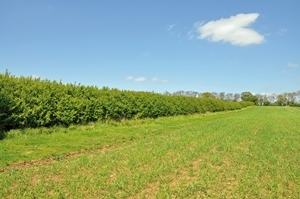By Henrietta Appleton, Policy Officer (England)
 Walking the dogs at this time of year provides a wonderful perspective on the architecture of the countryside. Many parts of the English rolling landscape are criss-crossed by hedgerows, which if one stops and looks provide an interesting perspective on the history of the landscape being observed.
Walking the dogs at this time of year provides a wonderful perspective on the architecture of the countryside. Many parts of the English rolling landscape are criss-crossed by hedgerows, which if one stops and looks provide an interesting perspective on the history of the landscape being observed.
Hedges identify field boundaries, prevent stock from wandering and provide shelter. But they also delineate lanes, bridleways, footpaths and other historic byways. Where I live these are often old droving roads from the time when farmers moved their livestock to market on foot, travelling for several days from Wales say to London; or the now often lost holloways of southern England, where constant use resulted in them ‘sinking’ below surrounding ground level due to the soft stone geology.
But looking closer at the hedge itself can provide more cultural history. Relict hedges can delineate long-forgotten boundaries and marches, and provide evidence of changes in farming from livestock to arable, therefore making the hedge redundant, and management practices with signs of former coppicing or laying.
As the BBC article on the work, led by the UK Centre for Ecology and Hydrology, mapping our hedgerows points out, hedges have been in existence since the Bronze Age as a means of marking ownership boundaries and keeping in livestock. There have been times when hedgerow planting was greater than others such as during the various Enclosure periods. In the 14th to 17th centuries, the open field and common land system was converted into ‘privatised’ areas of land (facilitated by the Statute of Merton). But the greatest change was initiated by the Enclosure Acts in the 18th and 19th centuries. In contrast, the post-war drive for food production and the increasing intensification of land saw significant hedgerow removal, with about half lost between the 1940s and 1990s. In each case the change in attitude towards hedgerows was encouraged by government policy and legislation.
Roll forward to now and the same applies. Hedgerows have become another tool of policy – this time for biodiversity, flood prevention and net zero reasons.
Whilst the value of hedgerows to these goals is not questioned, I am concerned that policy is creating an homogenised landscape. The aesthetic and cultural value of hedgerows is being undermined.
Hedgerow planting is now largely based on hawthorn, with the inclusion of dogwood, blackthorn and field maple (the traditional hedge mix on the Woodland Trust website), and management is usually done by flail. Whilst government replanting schemes encourage the use of species from the local area, with no one species comprising more than 70% of the hedge, I am concerned that many of the regional differences in species are being lost. The Devon Hedges website lists 24 species of plant that are frequently found in Devon.
In the past, things were different with no two areas having the same hedges or styles reflecting the climate, landscape and raw materials of each area. As with dry stone walls in the Yorkshire Dales, where folklore has it that if a Dalesman was blindfolded and dropped into a dale he would know where he was by the construction of the dry stone walls, there were differences between counties in how the layered hedge was made and ‘bound’ as well as in the species used. For example, in the livestock farming areas such as Derbyshire, a strong, stock-proof hedge is created by weaving the layed stems in front and behind the stakes; in Devon and Dorset the hedge is laid on top of a bank; and in the Midlands, where the livestock was cattle and horses, which required hedges to be able to withstand the weight of the animal pushing against them, the finished height was higher and hazel binders were woven along the top to give maximum strength. In contrast, in Yorkshire, where hedges delineated fields in sheep/arable rotations, the laid hedge might be thin as initially (and even up to five years) arable crops would be in the field, giving the hedge time to regenerate before grazing off by stock.
Such skills have been lost due to the cost and time to lay a hedge, and the easy solution now provided to keep stock in – the metal or electric fence. You can often see the traces of this practice in the bottom of a neglected hedge, as you can coppicing in woodland or hedgerows. Coppicing provided the farmer with firewood, thatching spars, hurdle timber, etc. Hornbeam was a favoured species that is not seen much these days.
The English landscape would also have comprised areas that were unhedged. I have already referred to the dry stone walls of the uplands, but the Fens, Romney Marsh and the chalk belt from Yorkshire to Dorset were also devoid of hedges with stone-faced banks, wattle hurdles and drainage ditches forming the boundaries. There is also the question of hedgerow trees. These are now being promoted by government policy but this practice was not widespread. We wrote a blog a while back pointing out that hedges have the potential to host 14 million trees, even omitting open arable landscapes and the hill fringe. The right-tree-right-place mantra applies to hedges as well as hedgerow trees, which, if introduced to open landscapes, can alter their cultural characteristics.
These cultural differences are a key part of our landscape, and as I walk my dog and look at the ‘skeleton’ of hedgerows across my local countryside, I mourn the fact that hedges have become another policy tool. Their biodiversity and carbon value is being promoted at the expense of their aesthetic and cultural value.